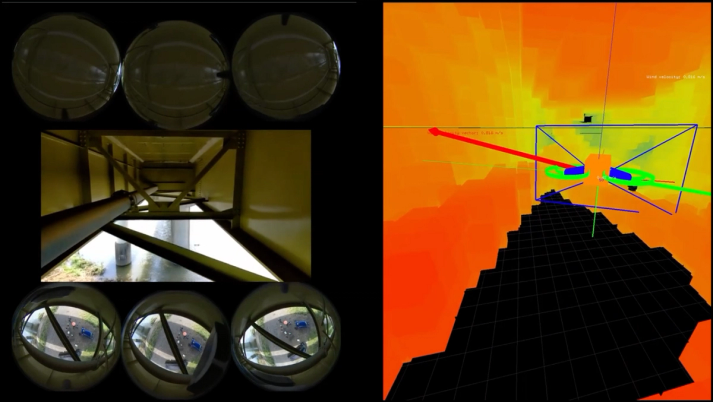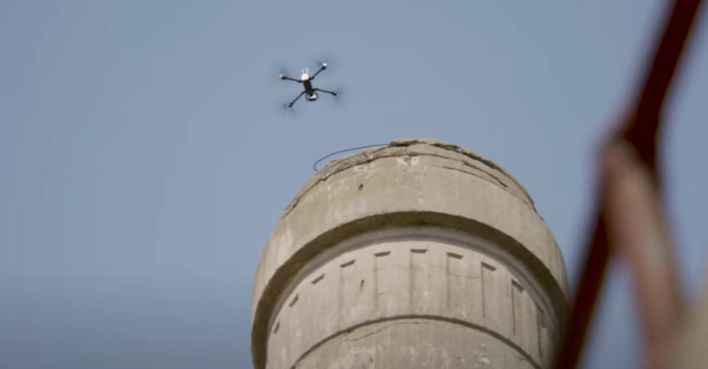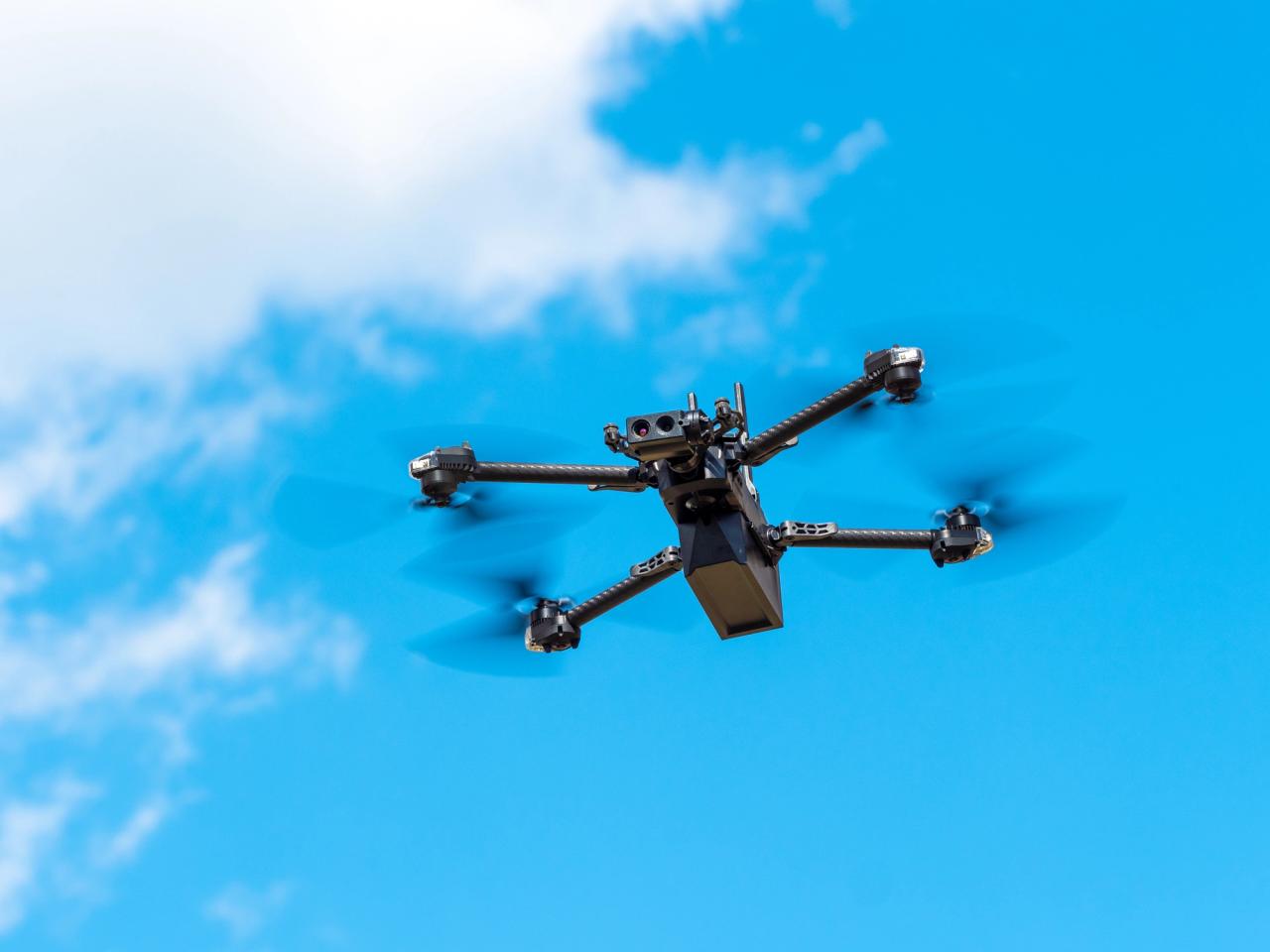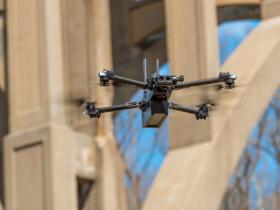Schedule a demo with our sales team today.
We are thrilled to celebrate Dominion Energy’s new Close Proximity, Low Altitude (CPLA) waiver authorizing Beyond Visual Line of Sight (BVLOS) flights enabling an array of inspections at more than 40 energy generation facilities across 7 states. This waiver is the result of collaboration between Dominion Energy and Skydio in the FAA BEYOND Program as part of the Virginia team, which is led by the Virginia Tech Mid-Atlantic Aviation Partnership (MAAP) with the Virginia Innovation Partnership Corporation.
“A 20-minute inspection by a battery-powered drone will increase safety for our colleagues, who will no longer need to rappel down the side of a structure, as well as save time during inspection-related preparations,” said Nate Robie, Dominion Energy’s manager of unmanned systems program. “As a pioneer in beyond visual line of sight drone use, Dominion Energy contributes to a safer, greener future, as well as potentially lowering operations and maintenance costs, which ultimately benefits our customers.”
This approval will enable Dominion to fly both safely and efficiently at dozens of facilities to maintain the supply of power to customers in seven states. We are honored to have played a role in helping scale the use of drones as an important tool for critical infrastructure inspection through Skydio revolutionary autonomy capabilities. In this blog post, I will explain the authorization and highlight some of the ways it will improve drone operations for power companies.
The Right Tech and Tactics: Autonomous Drones Enabling Inspection at Scale
The word “BVLOS” often conjures images of drones flying dozens or even hundreds of miles from the operator. But we’ve found that some of the most valuable BVLOS operations occur just beyond line of sight and behind structures or terrain. Power plants provide a perfect example. Visiting a power generation facility, you are struck by the size, complexity, and scale of the equipment. Every element of the plant must be regularly inspected. But that is no easy feat.

Drones make it easier to inspect equipment that is hard to reach, whether it’s high in the air, hot, or dangerous. And drones enable engineers to track changes and damages over time, supplementing important hands-on inspections. Those are some of the reasons why Dominion is leading the way in integrating drone technology into their all-important work to keep the lights on.

In these demanding environments, not just any drone will do. Skydio uses advanced computer vision technology to make drones capable of navigating complex environments, even areas without GPS or subject to electromagnetic interference (EMI). Power plants are a great example of facilities with high levels of EMI with confined spaces that may lack GPS signal. And that makes power plants perfect for Skydio’s products.
After they found the right technology, Dominion realized they needed the right regulatory tactics to make their program as efficient as possible. Under the current rules, pilots are required to keep their eyes on the drone, unless the FAA grants a waiver. In a power generation facility, maintaining line of sight while flying a drone can be difficult. Remote pilots may need to reposition themselves frequently to follow the drone as it ducks behind--and, in the case of Skydio drones, even inside-- the structures surrounding smoke stacks, boilers, and generators. Those constraints would impact the program’s efficiency and force operators to move from positions of safety.
At Skydio, we believe drones should work for you--not the other way around. That’s why we were honored to work with Dominion to secure this first-of-a-kind approval that permits remote pilots--such as plant engineers who are Part 107 certified drone pilots--to inspect the entire facility without repositioning themselves.
With layers of mitigation measures, including Skydio technology, the FAA waived the requirement for the human pilot to see the drone throughout the entire flight or for an additional crew member to constantly scan the airspace. This enables Dominion to conduct important timely inspections in an efficient manner, without compromising safety. Nor does it require any form of detect and avoid equipment, such as radar. This is true BVLOS.
Enabling “true BVLOS” operations is a core goal of our regulatory work. This is the third successful FAA waiver Skydio has written enabling BVLOS without visual observers or DAA. The first was the Tactical BVLOS waiver we prepared for the Chula Vista Police Department in 2020 (which has now scaled to hundreds of first responder agencies), and the second was North Carolina Department of Transportation’s waiver to inspect bridges statewide --both without visual observers or DAA. And we’re just getting started.
The “secret” behind these advances is CPLA--Close Proximity, Low Altitude operations, also known as shielded operations. Shielded operations are conducted where helicopters and aircraft are very unlikely to fly to maintain their own safety. Those operations typically occur:
- Very close to the ground - below 100ft above ground level (AGL) (an altitude much lower than the 400 ft height ceiling for drones in Part 107)
- In close proximity to structures, at distances of less than 100ft (and sometimes less)
- A safe distance away from airports and heliports
- Directly over industrial facilities and other critical infrastructure
Understanding the Waiver: Demonstrating Scalable, Efficient BVLOS Operations
Important to realizing the safety gains offered by use of drones for inspection is the ability to scale the operations – having the right drone, the right BVLOS approval, and the right operating procedures in place enables an organization to scale the use of drones and ultimately realize the benefits of a drone program.
As discussed, at power generation facilities, Dominion Energy drones take volumetric measurements and assess construction progress, provide surveying and mapping services, and inspect infrastructure. To help Dominion conduct these inspections more efficiently than ever before, the Skydio Regulatory Team prepared an advanced waiver for Dominion’s world-class UAS team. We are thrilled to see the FAA grant a waiver to our partner.
Summary of the key features of the Dominion Energy waiver:
- Allows Dominion to conduct BVLOS operations over its energy generation facilities at or below 100 ft AGL and within 100ft laterally or vertically of structures.
- Does not require additional VOs or ground- or air-based surveillance capability because the operations take place in airspace where manned aircraft are unlikely to be encountered.
- Allows for operations at locations at least 3 miles from airports or helipads.
- Requires Dominion Energy to take appropriate measures to ensure that non-participants are wearing PPE and are notified that drone operations are taking place at the facility.
- Allows Dominion to scale the operation across its territory - to over 40 facilities in 7 states.
Importantly, the waiver covers more than 40 Dominion facilities in Connecticut, Georgia, Indiana, North Carolina, South Carolina, Virginia, and West Virginia.

Under the BEYOND Program, the FAA is tackling the challenges of UAS integration, one of which is BVLOS operations that are repeatable, scalable and economically viable with specific emphasis on infrastructure inspection. Because there is no requirement for additional personnel or expensive and complex airspace surveillance or detect and avoid technology, CPLA BVLOS operations are scalable and economically viable. These are low risk operations designed to lower aviation risk and enhance the safety of the inspection procedure in a way that is viable for the power generation industry. This concept was recently echoed in the FAA BVLOS Aviation Rulemaking Committee Report which included recommendations on enabling CPLA BVLOS and other types of “Shielded Operations.”
Dominion’s approval demonstrates how Skydio enables its customers to fly drones safely, efficiently, and in compliance with civil aviation regulations. Skydio takes great pride in the fact that this achievement will help scale inspections at energy generation facilities, and we look forward to continuing to work hand-in-hand with inspection teams and the FAA to help this class of operations take flight.



